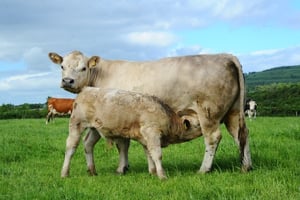If you control worms, it will allow your cattle to perform well and be free of clinical disease. But they are able to tolerate a certain amount of parasites. Wormers should therefore be used sensibly to control costs and any unwanted side-effect. How much cattle can tolerate depends on a few key points:
Young stock - First grazing season
The risk with young stock depends on when they were born, and if they have been weaned or are grazing with their mothers.
Weaned calves that are grazing for the first time are at the highest risk, if the pastures have carried cattle in the last 12 months. They have no immunity and rely solely on grass for food.
Sucklers can be susceptible. But they benefit from their mothers' milk, which provides some protection from the effects of worms.
Spring-born calves are at the lowest risk, as grass only comprises a small proportion of their intake.
Young stock - Second grazing season
Many important targets can occur during this season, including breeding replacement heifers and finishing of non-breeding stock. The biggest potential impact of parasites on these animals will be on the growth rate. Any reductions in live weight gain will delay service or marketing.
Consequently, a good indicator for worm control and treatment is live weight gain, if there are no other more obvious causes of poor growth. If your farm has a high risk for fluke, it will also need to be controlled in yearlings.
Adult Cattle
-1.jpg?width=300&name=Cows%20and%20Calves%20(Medium)-1.jpg) If adult cattle had adequate exposure, they are generally immune to gut- and lung-worms. But under certain conditions, diseases can occur.
If adult cattle had adequate exposure, they are generally immune to gut- and lung-worms. But under certain conditions, diseases can occur.
Beef cows normally do not need routine treatments. Worming at housing can still be an option to reduce gut- and lung-worm populations with low risk.
As there is no immunity to liver fluke, cows that graze on fluke prone pastures will need treatment at least once a year.
Bulls are more susceptible than cows, so they may benefit from worming. For the best performance, treatment should be started before the breeding season.
Monitoring
To control parasites, it is important to monitor young stock on an on-going basis.
Perform daily checks for clinical signs of disease, such as coughing, scouring, anaemia or weight loss.
Monitor the growth rates.
To get an idea of how heavily your pastures are contaminated, take faecal samples and perform worm egg counting. However, these cannot indicate the impact of worms on the health and performance of your animals. If you find fluke or lung worms in faecal samples, it is a strong indicator that treatment is required.
How to take faecal samples
- The sample should be fresh and less than an hour old
- Use an air tight bag or container
- Keep the sample cool, but not frozen
- Deliver the sample to a lab within 48 hours
- Lungworm samples should be delivered as soon as possible
Targeted treatments
For the best performance, any treatment should be targeted according to the type of worms, their life cycle stages, the time of the year and treatment history.
Wormers of the three main groups differ in formulation, activity, duration and withdrawal period. Always obtain advice on the appropriate product to use.
Take special care when using combination products with broad spectrum wormers. Do not use them when a specific parasite is the target for control.
Keep susceptible worms on the farm
A strategy of dosing all cattle and moving them to low contamination pastures is considered highly selective for anthelmintic resistance. Mitigate the risks to take advantage of low risk fields: leave a few fit animals untreated, do not graze the paddock with young cattle, and delay moving after dosing. This will allow treated calves to become lightly reinfected with susceptible worms, therefore diluting the numbers of resistant worms.
Reduce the reliance on chemicals
Efficient grazing management provides high-quality nutrition for cattle. This can help them to withstand the effect of worms. It can also reduce the risk of worm infections when grazing.
Utilise low risk pastures and avoid infective grazing to reduce the risk of lung worms. To avoid liver fluke, do not let cattle on damp grazing areas that contain mud snails, especially in late summer and autumn.
Most gut and lung worms are exclusive to cattle. If you have other livestock available, mixed and sequential grazing can be an effective system to reduce the number of worm larvae on pastures.
Mature cattle with partial immunity to worms usually pass dung that contains fewer worm eggs. These animals do not contaminate pastures to the same extent.
Read more about:
Getting your worming strategy right
Understanding the different cattle wormers and reducing resistance on your farm
Increase wormer efficiency with correct usage



